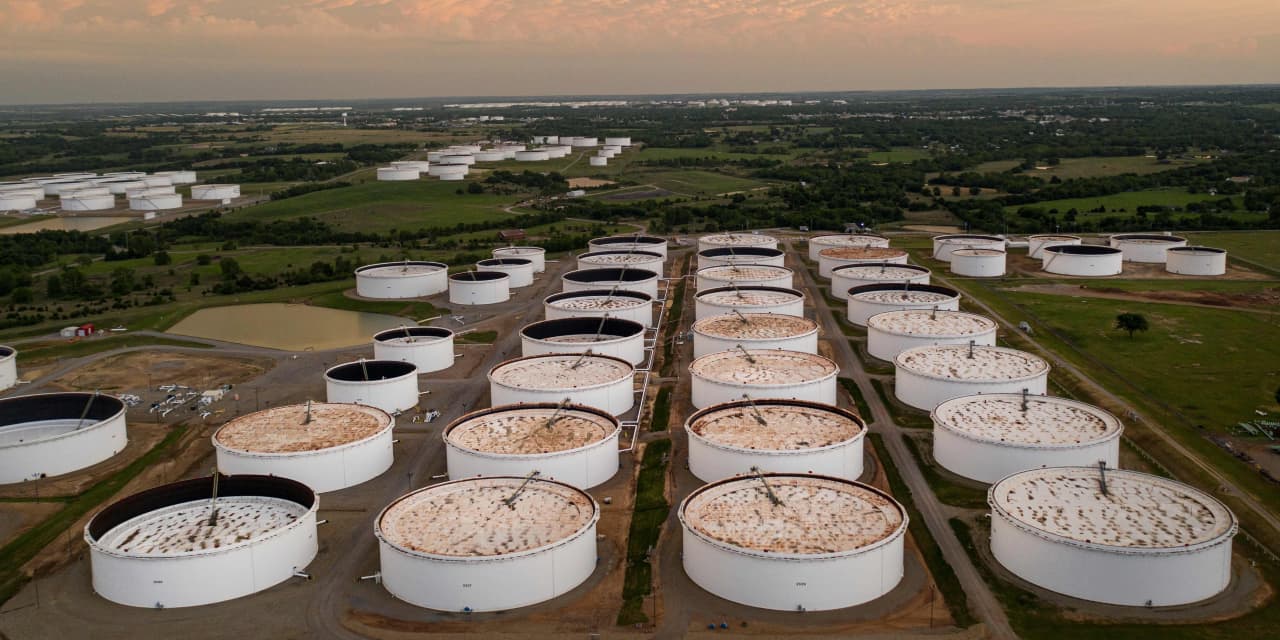U.S. oil prices settled below $70 a barrel on Wednesday for the first time since late June, down a fifth straight session, after U.S. data showed a hefty weekly climb in domestic gasoline inventories.
Traders also continued to weigh the prospects that OPEC+ will follow through with its voluntary production cuts in the first quarter of the new year.
Price action
-
West Texas Intermediate crude for January delivery
CL00,
+2.57% CL.1,
+2.57% CLF24,
+2.57%
fell $2.94, or 4.1%, to settle at $69.38 a barrel on the New York Mercantile Exchange, the lowest for a front-month contract June 27. Prices fell a fifth session in a row, which marked the longest losing streak since February, according to Dow Jones Market Data. -
February Brent crude
BRN00,
+2.32% BRNG24,
+2.32% ,
the global benchmark, dropped $2.90, or 3.8%, to $74.30 a barrel on ICE Futures Europe. Brent also posted a fifth loss in a row at the lowest since June 28. -
January gasoline
RBF24,
+2.53%
shed 3.8% to 2.03 a gallon, while January heating oil
HOF24,
+1.16%
declined by 2.5% to $2.58 a gallon. -
Natural gas for January delivery
NGF24,
+0.46%
fell 5.2% to $2.57 per million British thermal units.
Market drivers
Oil futures have been under pressure since Thursday, when the announcement of additional production cuts by the OPEC+ — made up of the Organization of the Petroleum Exporting Countries and its allies — left traders underwhelmed.
“Investors remain relatively unmoved by the potential impact that the additional voluntary production cuts agreed by the OPEC+ members will have on the market,” Ricardo Evangelista, senior analyst at ActivTrades, said in a note.
“Since the last day of November, the price of Brent has dropped more than 6%, showing that the markets’ concerns are tilted towards the demand side, as fears over an economic slowdown gain traction,” he wrote.
OPEC+ producers agreed last Thursday to voluntarily cut around 2.2 million barrels a day (mbd) of crude from the market in the first quarter of next year, a figure that included a widely expected extension of Saudi Arabia’s 1 mbd voluntary output cut and Russia’s 300,000 barrel-a-day cut to crude exports.
The voluntary nature of the overall cuts left traders skeptical over whether producers will comply, analysts said.
See: Why the rally in uranium that lifted prices to a 15-year high may not be over
Oil bulls on Wednesday got “another headache after Saudi Arabia lowered its official selling prices for January loadings to the key Asian market — for the first time in seven months, said Stephen Innes, managing partner at SPI Asset Management. “This development supports the perception that market fundamentals are softening as the first quarter of 2024 approaches.”
Overall, “it feels like there is buyer exhaustion kicking in, and it could be challenging to drive positive movement in the absence of a significant draw on visible [oil] inventory at a time of year when big institutional market moving desks” are concerned about holding on to their year-end bonuses, he told MarketWatch.
Additionally, oil tends to follow U.S. GDP, and by all accounts, we should be in for a significant drop from the third quarter, Innes said. “With compliance fissures in OPEC and a surprising upswing in U.S. oil production…[that] paints a less bullish picture into year’s end.”
Supply data
Meanwhile, the Energy Information Administration released Wednesday revealed that U.S. commercial-crude inventories fell by 4.6 million barrels for the week ending Dec. 1, marking the first decline in seven weeks.
The fall was larger than the average 4.1 million barrels forecast by analysts polled by S&P Global Commodity Insights. The American Petroleum Institute reported a rise of 594,000 barrels Tuesday, according to a source citing the data.
The EIA also reported supply increases of 5.4 million barrels for gasoline and 1.3 million barrels for distillates. The S&P Global Commodity Insights analyst forecast called for supply gains of 800,000 barrels each for gasoline and distillates.
“Builds in refined products stocks should continue to be the focus as we move into 2024,” said Troy Vincent, senior market analyst at DTN.
U.S. refiners are “finally emerging from maintenance and when combined with demand weakness and an El Nino-driven weather pattern, which should prevent refinery shut-ins this winter like we have seen for the past two years, this sets the stage for much more robust end-of-winter fuel inventories,” he told MarketWatch.
Total motor gasoline supplied, a proxy for demand, averaged 8.5 million barrels a day over the past four weeks, up 1.1% from the same period last year, EIA data showed.
Crude stocks at the Cushing, Okla., Nymex delivery hub, meanwhile, rose by 1.9 million barrels last week, the EIA said. Domestic petroleum production edged down by 100,000 barrels to 13.1 million barrels a day.
Read the full article here




